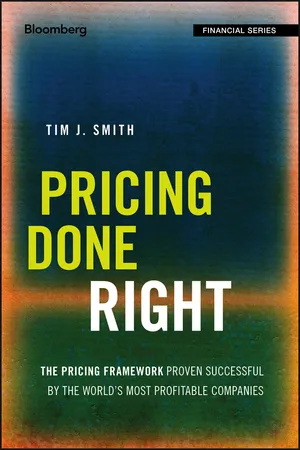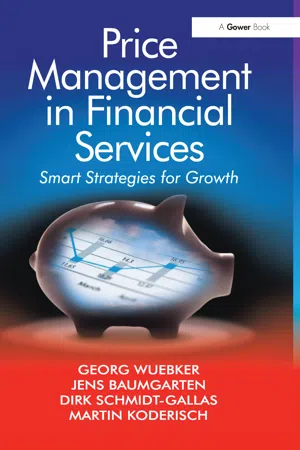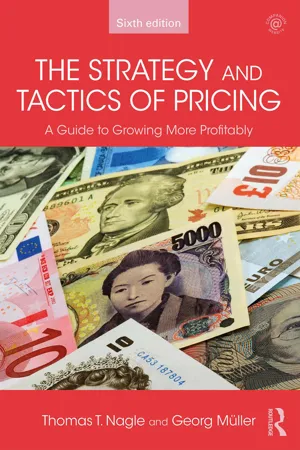Business
Pricing Strategies For Market Leaders
"Pricing Strategies for Market Leaders" refers to the various approaches that leading companies use to set prices for their products or services. These strategies often involve setting premium prices to reflect the brand's perceived value and maintain a competitive edge. Market leaders may also employ dynamic pricing, value-based pricing, or penetration pricing to maximize profits and market share.
Written by Perlego with AI-assistance
Related key terms
Related key terms
1 of 4
Related key terms
1 of 3
11 Key excerpts on "Pricing Strategies For Market Leaders"
- eBook - ePub
Pricing Done Right
The Pricing Framework Proven Successful by the World's Most Profitable Companies
- Tim J. Smith(Author)
- 2016(Publication Date)
- Wiley(Publisher)
CHAPTER 4 Pricing StrategyThere are four pricing decisions that senior executives face in the strategic pricing area. These strategic pricing decisions require executive attention because, as an input, the actual pricing strategies chosen need to be aligned with the chosen business strategy to exploit or enable the development of the firm’s relative competitive advantage, and, as an output, the information gathered in developing these pricing strategies informs the range of business strategies that may be successful.These four pricing strategy issues are:- Price positioning
- Price segmentation
- Competitive price reaction strategy
- Pricing capability
Each of these strategic pricing decisions is directly dependent on and influences the firm’s business strategy including the customers it serves, its competitive engagement, and its company strength. As such, they deserve senior executive—if not boardroom—attention and should engage the entire executive suite. Rather than having pricing reactions drive their business, leading firms are using their business strategy to proactively drive their pricing strategy.Price positioning directly reflects the firm’s customer acquisition strategy in light of its competitive and company strategy. Price segmentation drills down into the firm’s customer strategy while also reflecting its corporate capabilities. Competitive price reaction strategy is a direct consequence of the firm’s competitive strengths. And pricing capabilities and their development are a direct consequence of the firm’s company strategy aligned to all other strategic business issues.There are many other pricing questions of merit, such as the specific prices to put on specific offers or the pricing of specific transactions. These managerial pricing decisions are extremely important, but they should be made to align with the above pricing strategy decisions rather than having a pricing strategy that is determined by individual managerial pricing decisions made on a daily ad hoc basis. - eBook - ePub
- Paul Reynolds, Geoff Lancaster(Authors)
- 2005(Publication Date)
- Routledge(Publisher)
Marketing management should devise a pricing strategy that is compatible with strategies attached to other elements of the marketing mix. It is not always possible to set a price and apply this rigidly to all customers in all market situations. A pricing strategy denotes how a company will price its products at particular periods of time or particular market conditions. Demand-orientated pricing sets a base price that the company must endeavour to achieve, but it assumes that price be modified in line with changes in demand. Manufacturers must realise that customers are not the same. Some will purchase greater quantities than others, or be situated in areas that are more costly to reach.If a target-return-on-investment price is set, this may only be appropriate during the maturity stage of the product life cycle that was explained in the last chapter. During introduction or growth, it is often necessary to employ a pricing strategy that will enable the target return to be achieved over the long term.A company’s ability and willingness to formulate pricing strategies is a reflection of its willingness to adapt and modify price according to the needs of customers and market conditions.7.6.1 Discounting
The discount structure a company employs is a major element of pricing strategy and an indicator of the firm’s flexibility. If customers buy products in large quantities, they may reasonably expect to be charged a lower price than that charged to smaller purchasers. The seller may also offer discounts voluntarily in order to encourage large orders that facilitate economies of scale and assist effective production planning. Such quantity-related discounts can refer to individual orders or be based on an estimated off-take that is planned over a given period. In certain markets, price discounting is important. Day and Ryans (1988 ) say that if used with imagination and creativity they can provide a firm with a strong competitive advantage.Manufacturers can offer discounts to encourage sales of a new product or accelerate demand for a product whose stocks are high, owing to seasonal or cyclical demand variations. In the production context, it is desirable that a constant rate of output is maintained. If market conditions are not conducive to this, a price modification by means of discounting might encourage sales sufficiently to counteract variations in levels of demand. - eBook - ePub
- Geoffrey Lancaster, Lester Massingham(Authors)
- 2017(Publication Date)
- Routledge(Publisher)
3 We can also see that, according to the precise objectives, we might arrive at very different prices for our product and services. Where a company has multiple objectives, pricing strategies may need to consider tradeoffs between different possible price levels, such that these different objectives are met.In addition to these broader corporate objectives, pricing decisions must also reflect and support specific marketing strategies. In particular, pricing strategies need to be in line with market targeting and positioning strategies, which were outlined in Chapter 3 . Clearly, if a company produces a high-quality product or service aimed at the prestige end of the market it would not be sensible to set a low price even if cost efficiency allowed this. Pricing, therefore, must be consistent with the other elements of the marketing mix and the selected positioning strategy. Effectively, the selection of company and market objectives, market targets and the formulation of a positioning strategy constrain or delineate the range of pricing strategies and specific price levels.An example of how price must reflect and support the overall positioning strategy of the company is the price set for the Aston Martin DBS. The car is positioned at the top end of the market and with just 500 made in the UK for sales worldwide the emphasis is on exclusivity. Many people still associate Aston Martin with the character James Bond, emphasizing the racy and prestigious image intended. Prices start at £160,000.Demand considerations
A key parameter affecting pricing decisions is customer based. The upper limit to the price to be charged is set by the market, unless the customer must purchase the product and we are the sole supplier. In competitive markets, demand – that is, the price customers are willing and able to pay – is a major consideration in the selection of pricing strategies and levels. It is in the analysis and interpretation of demand and demand schedules - eBook - ePub
- Ross Brennan, Louise Canning, Raymond McDowell(Authors)
- 2020(Publication Date)
- SAGE Publications Ltd(Publisher)
The point of the pricing wheel is to emphasize that pricing is not a decision that is taken once and then forgotten about. Rather, pricing is a more or less continuous process, in which pricing decisions must be constantly updated to take account of factors within the control of the firm, such as new product features, and factors outside of the control of the firm, such as new competitor pricing strategies. The first decision to be made is how great a role pricing is to play in the overall marketing strategy. In industries with highly customized products that are designed specifically to meet the needs of each individual customer, price is a comparatively unimportant component of marketing strategy. Naturally, there are other industries, such as the office-cleaning sector, for example, where price is a much more important factor. Even within a single industry sector, there is scope for a firm to put more or less emphasis on price as a component of its marketing strategy – if the firm positions itself as a differentiator offering enhanced customer value, then it will de-emphasize price as a factor in its marketing strategy.Although business-to-business organizations may pursue a very wide range of price objectives, research has shown that the most common objectives are concerned with profits, survival, sales volume, sales revenue, market share, image creation, competitive parity or advantage, barriers to entry and perceived fairness. Of these, profit targets are the most common. Survival pricing usually only arises in industries with chronic overcapacity, where firms are desperate to make as much use as possible of their fixed assets. Pricing to maximize sales or market share will generally imply lower prices than profit-driven pricing, and may indicate a longer-term orientation (with the strategic aim of building a dominating position in the market) or a belief that higher market share will inevitably bring about higher profits. It is well known that there is a correlation between profitability and market share (Buzzell and Gale, 1987), but there is no obvious reason to suppose that this shows that higher market share causes - eBook - ePub
Price Management in Financial Services
Smart Strategies for Growth
- Georg Wuebker, Jens Baumgarten, Martin Koderisch(Authors)
- 2017(Publication Date)
- Routledge(Publisher)
Price management is not simply a matter of raising or reducing prices – the parameters which can be improved are far more complex. These parameters include incentives, price structures (such as multi-dimensional or non-linear prices), price bundling and differentiation.Setting clear and unambiguous goals and principles for pricing and product policies are the key to running efficient pricing processes and avoiding common conflicts (i.e. profit versus sales growth). Often these are not even in written form, which is crucial if they are to be developed and prioritized.- To further improve the pricing process, it is important to increase the knowledge of pricing issues across the entire organization. Commitment from the company’s senior management is vital.
Pricing cannot be separated from cost and brand considerations, so it is common practice to pursue a mix of goals. The examples of Postbank, ING Direct, Allianz and Sal. Oppenheim prove that the general competitive strategy sets the stage for the pricing strategy (e.g. general price leadership versus service differentiation).To properly link pricing to the competitive strategy, knowledge of the relative importance of decision criteria is vital. These aspects can be summarized in a matrix of competitive advantages which identifies strategic competitive advantages and disadvantages. A financial institution can only survive in the long term if it has at least one competitive advantage.The aim of segmentation is to group customers according to certain criteria (e.g. preferences) in such a way that the customers within each group are homogenous, but as heterogeneous as possible when compared to customers in other groups. Segments can be approached using segment-specific marketing initiatives and pricing strategies. The dilemma of segmentation is that only difficult to observe behavioural criteria (e.g. customer preferences or willingness-to-pay) are directly relevant for segment-specific marketing and pricing. On the other hand, socio-economic indicators (such as income or assets under management) are easier to observe, although their relevance for use in creating segments is unclear. Many financial institutions segment their customers based on observable indicators without associating them with behavioural criteria such as preferences or price sensitivity. - eBook - ePub
Game Changer
How Strategic Pricing Shapes Businesses, Markets, and Society
- Jean-Manuel Izaret, Arnab Sinha(Authors)
- 2023(Publication Date)
- Wiley(Publisher)
- Costs, value, and competitor prices all vary for different reasons in different circumstances. Understanding the combined effects of these variations and how to take advantage of them is the essence of strategic pricing.
Passage contains an image
CHAPTER 2 Four Economic FrameworksBusiness leaders often confuse pricing methods with pricing strategies, so it is important for us to distinguish sharply between the two. Pricing methods yield a price number as a finite output. These outputs can vary significantly, depending on the information sources used, as the cupcake entrepreneur learned at the end of Chapter 1 .Pricing strategies demand that leaders look beyond prices – beyond the numbers – to take the entirety of their current and future market situations into consideration, rather than focusing narrowly on one input or one method to the exclusion of other information. Pricing strategies express intentions and offer guidance and direction. They are subjective and require astute judgment.The next step in going beyond prices and developing a pricing strategy is to look at the combinations of the three information sources. Cost, competition, and value can generate important and more powerful insights in combination than in isolation. The intersections we show in Figure 2.1 show the four natural overlaps that result in practical frameworks backed by large bodies of economic theory.Venn diagram of information sources forming four economic frameworksFIGURE 2.1The frameworks at the respective overlaps – elasticity, differentiation, game theory, and supply and demand – form Layer 2 of the Strategy Hex. Each of these frameworks can either facilitate or hinder strategic pricing decisions, depending on how business leaders apply them. Figure 2.1 - eBook - ePub
Entrepreneurship Marketing
Principles and Practice of SME Marketing
- Sonny Nwankwo, Ayantunji Gbadamosi, Sonny Nwankwo, Ayantunji Gbadamosi(Authors)
- 2020(Publication Date)
- Routledge(Publisher)
Chapter 8Choosing the right pricing strategy
P. Sergius KokuINTRODUCTIONLEARNING OBJECTIVESAfter reading this chapter, you will be able to:Develop an appreciation for complexities in pricing;Develop pricing objectives;Develop appreciation for the interface between pricing decisions and law;Develop appreciation for the internal and external factors that affect pricing decisions;Be able to discuss pricing variables and the various pricing objectives;Understand the differences in the pricing process in SMEs and large organisations;Choose an appropriate pricing strategy;Be able to do simple calculations involving markup and break-even volume.Regardless of firm size, pricing is one of the most critical activities that take place within the firm. The importance of the pricing process to a firm lies in the fact that pricing is the only means through which a firm can generate revenue. A mistake in the process could be costly to the firm. Pricing mistakes may not only make the firm less profitable but also they can result in a firm’s bankruptcy and its eventual closure.Because of its importance, pricing has attracted a significant research effort in many academic disciplines such as marketing, economics, and law. Because it can be easily mimicked by competition, firms do not rely solely on price for their competitive strategy. However, price’s uniqueness as a strategic tool is reflected in the fact that it is about the only corporate activity that goes by several different names, depending on the context. For example, it is referred to as a ‘fare’ in the transportation industry, a ‘fee’ in education and its related business, ‘cover’ in the entertainment industry, and ‘price’ in many other situations.Regardless of what it is called, the primary objective of price is to cover all the costs incurred in making a product/service and to produce profit while it still appeals to the intended target market. The issue of whether products or services must be priced to maximise profit is a seemingly simple but in fact rather vexing one and will not be discussed in detail here. However, suffice it to say that, while some economists believe that pricing must be used as a tool to maximise profit, behavioural economists take the view that profit maximisation is not the object of the firm. Cyert and March (1963), for example, have argued that because of the interactions that take place within firms, the wide range of personal objectives that are held by the employees, as well as the constraints that exist, firms aim to achieve profits that would be satisfactory to their disparate stakeholders, instead of trying to maximise profits. - eBook - ePub
Pricing and Profitability Management
A Practical Guide for Business Leaders
- Julie Meehan, Mike Simonetto, Larry Montan, Chris Goodin(Authors)
- 2011(Publication Date)
- Wiley(Publisher)
8Penetration pricing, also known as a low-price strategy, undercuts competitors and resets customer expectations over what products are worth. Useful in mature markets where competitive differentiation is difficult to achieve, price can substantially influence the purchase process. Southwest Airlines is another company that has employed this approach, much to the dismay of incumbents in the industry.9Maintaining a penetration pricing strategy can be risky if a business does not understand its financial position relative to its rivals. It must have a strong grasp of each competitor's margins, financial health, and competitive psyche. Are competitors likely to match the low prices or to surrender that part of the market? How critical are those products to the financial wellbeing of the competitors? Answering these questions will provide some insight into the expected reaction.A company must also understand its own financial state. Can it outlast a competitor in a price war? How does its margin compare to competitors' margins at different price points? At Vizio, sales overhead comprised less than 1 percent of sales, while in most consumer electronics companies it comprised closer to 10 percent.10 Borrowing from the Dell model of buying components just in time, Vizio pays the lowest prices possible for components at the moment when a television is assembled.11 - eBook - ePub
The Strategy and Tactics of Pricing
A Guide to Growing More Profitably
- Thomas T. Nagle, Georg Müller, Evert Gruyaert(Authors)
- 2023(Publication Date)
- Routledge(Publisher)
Organizational structure, decision rights, processes, and incentives are important levers that provide managers with the opportunity to make pricing choices in different and more profitable ways. Transforming an organization into one that commits to and executes on the principles of strategic pricing requires that managers act in ways that may run counter to their past experience and training. Some individuals may be resistant to change because they legitimately believe that the new approach is less effective, while others may be resistant because their compensation would be adversely affected under the new approach. Regardless of the reason, individuals must be motivated to go through a potentially uncomfortable transition process before accepting a new pricing strategy.There are a number of levers that can be used to facilitate adoption of the new approach including clear leadership from senior management and demonstrating successes through trial projects. Successful change efforts require an integrated and consistent use of these change levers to overcome organizational inertia and effect change.Senior Management Leadership
One of the most important actions that leaders can take to encourage adoption of strategic pricing is to truly “talk the talk and walk the walk.” All too often, senior managers indicate strong support for a new pricing strategy and then revert to ad hoc discounts the first time a customer asks for a lower price. Not only must senior leaders avoid falling back on old pricing practices, but they must also actively seek high-profile opportunities to demonstrate support for the new strategy. A telecommunications company we worked with had invested heavily to develop a more strategic approach to pricing in its consumer markets. The implementation plan included extensive training for the sales team and conducting a couple of high-profile negotiations with the new approach to demonstrate its effectiveness. The company seemed to be on its way to making a successful transition when the COO, who had been a tireless advocate for the strategy, began to respond to pressure from the board to meet sales targets by offering “one-time” discounts to win business. As soon as the regional sales managers learned about these discounts, they demanded the right to negotiate similar discounts. It was not long before these pricing “exceptions” became the norm across the organization and the pricing strategy was abandoned. In this example, the COO missed a critical opportunity to send a clear message about the organization’s commitment to the new strategy and, instead, began the process that left the organization stuck in its old pricing habits. - eBook - ePub
The Strategy and Tactics of Pricing
A Guide to Growing More Profitably
- Thomas T. Nagle, Georg Müller(Authors)
- 2017(Publication Date)
- Routledge(Publisher)
Chapter 10 Specialized Strategies Adapting Pricing to Accommodate Common Challenges If you always do what you’ve always done, you will only get what you’ve always got. Anonymous There are infrequent, yet common, strategic pricing challenges that can damage profitability unless recognized and managed appropriately. Appropriate management generally requires changing goals and patterns of organizational behavior to reflect a change in circumstances. Someone with cross-functional authority—perhaps someone in top management, perhaps an empowered manager of strategic pricing—must recognize the challenge and create an organizational or a cross-functional process to address it. The purpose of this chapter is to identify some of those challenges, enabling you to anticipate and thus to manage them proactively. They are as follows: Adapting pricing strategy over the product category life cycle Managing export prices in foreign currencies Managing pricing when markets slump Establishing transfer prices to maximize profitability across profit centers. While the discussions that follow describe practices for dealing with each of these challenges, they also illustrate how understanding pricing issues that we have dealt with individually—customer value, competition, costing, and internal organization—can reveal still more opportunities for profit improvement when considered collectively. Adapting Pricing Strategy Over Category Life Cycle The market for a product category passes through predictable phases, each with its own challenges for pricing (see Exhibit 10-1). Innovations, which offer customers new benefits that they could not achieve previously, require convincing customers that they should include the new category in the set of things they purchase. Growth in a product category requires aligning value with price across emerging market segments - eBook - ePub
Strategies for High-Tech Firms
Marketing, Economic, and Legal Issues
- P.M. Rao, Joseph A. Klein(Authors)
- 2015(Publication Date)
- Routledge(Publisher)
3Pricing Strategies for High-Tech Products and Services
CHAPTER OVERVIEW
This chapter discusses how several distinguishing features of high-tech products and services guide their pricing strategies. The chapter then provides a detailed discussion of examples of pricing strategies from three high-tech sectors—pharmaceuticals, commercial jet aircraft, and software. In addition, the chapter discusses the concept of disguised price discrimination, bundling, experience curve pricing, penetration pricing, bandwagon effects, and pricing of technology.INTRODUCTION
Pricing strategies for high-tech products and services are guided by several features of such products and services that distinguish them from other products. Below, the differences are highlighted.First, high-tech products and services are highly differentiated. A high degree of R&D intensity often accompanied by a high level of complementary promotional intensity is an indicator of a high degree of differentiation. Differentiation provides a degree of control over prices for the firm. That is, the firm becomes a price setter (Apple, for example) rather than a price taker (a wheat farmer in Kansas, for example). The degree to which firms have control over prices depends on the market structure in which they operate. Price setting firms are said to operate in a market structure of imperfect competition and price taker firms are said to operate in a perfectly competitive market. In a market structure of imperfect competition, firms engage in nonprice competition based on quality, service, brand name, and other qualitative factors.In a perfectly competitive market, firms compete on the basis of price. When high-tech firms compete on the basis of quality and brand name, they enter into an R&D and promotion race in which only a small number of firms survive and the threat of new entrants is low. Economists classify imperfectly competitive markets into three broad market structures: monopolistic competition (many producers with real or apparent product differentiation, e.g., cell phones and personal computers), oligopoly (few producers with varying degrees of product differentiation, e.g., autos and commercial jet aircraft at the high end of differentiation and aluminum and steel at the low end), and monopoly (single producer with no real substitutes, e.g., patented drugs and Windows operating system). Producers in each of these market structures face downward sloping demand curves with varying degrees of control over prices—of the greatest degree in monopoly—achieved through investment in R&D and promotion. Another way to think about investments in R&D and promotion is that they are aimed at creating a market structure favorable to the firm, namely a monopoly or a near monopoly.
Index pages curate the most relevant extracts from our library of academic textbooks. They’ve been created using an in-house natural language model (NLM), each adding context and meaning to key research topics.
Explore more topic indexes
Explore more topic indexes
1 of 6
Explore more topic indexes
1 of 4










